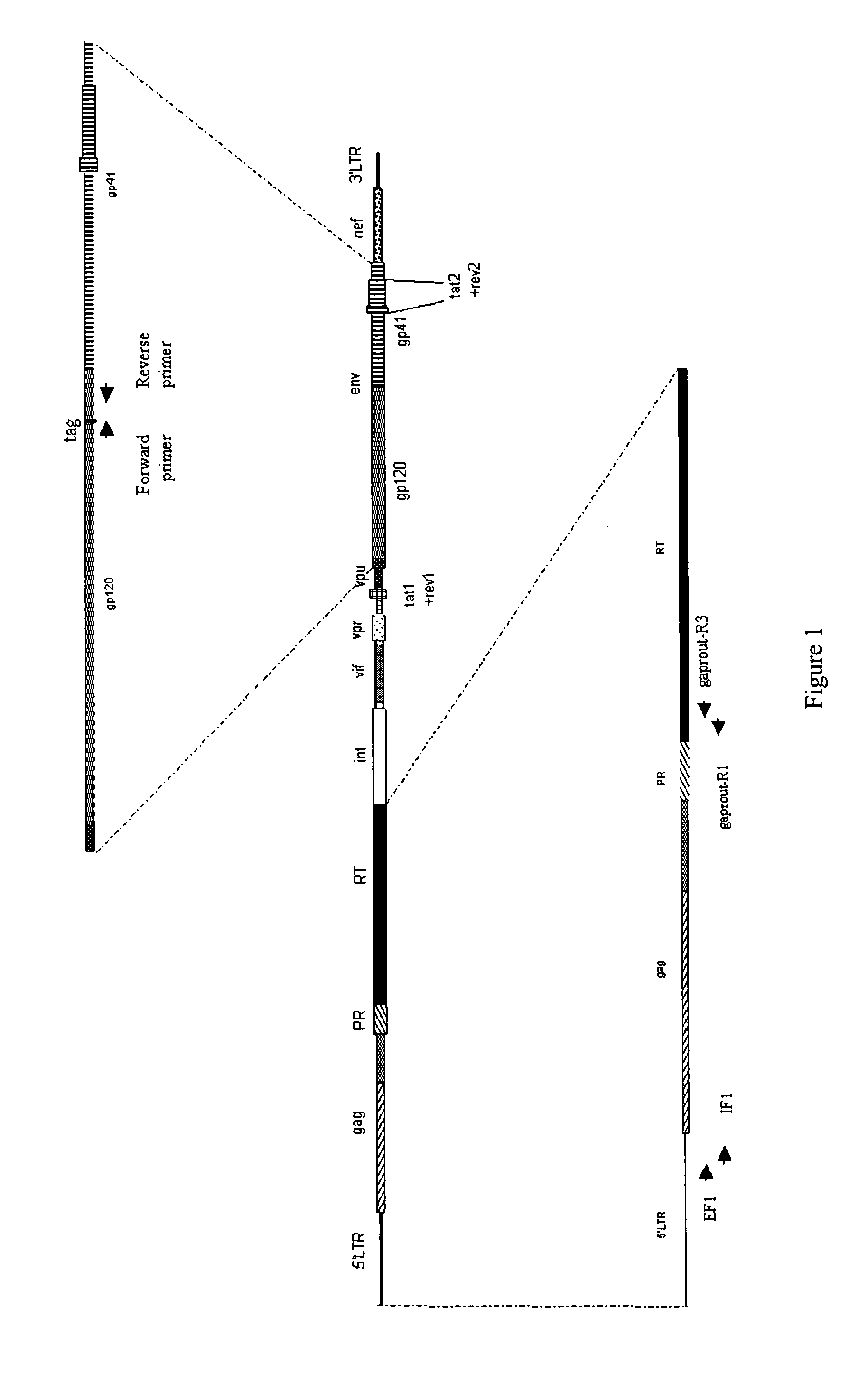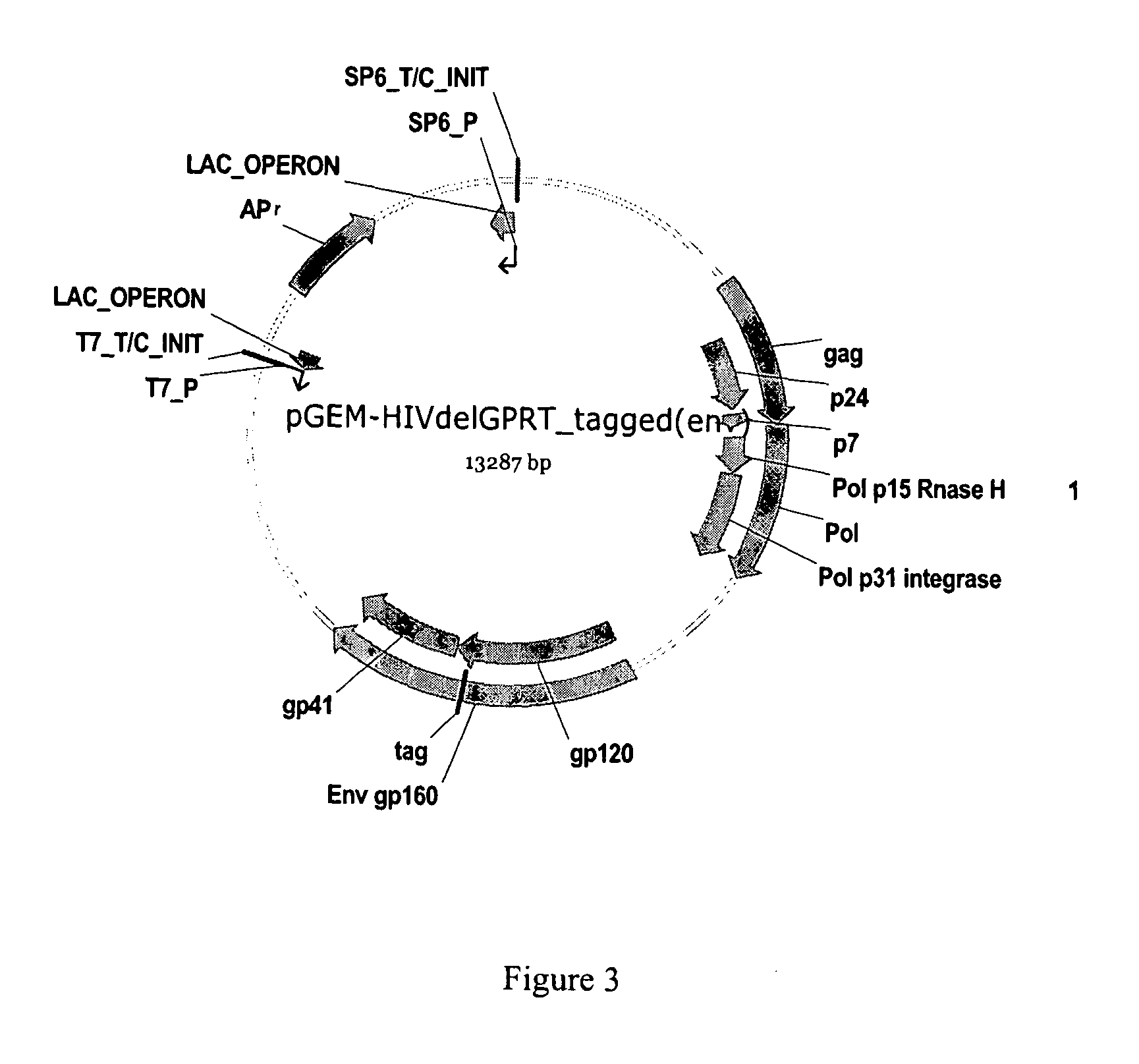Methods, plasmid vectors and primers for assessing HIV viral fitness
a technology of viral fitness and plasmid vector, which is applied in the field of methods and means for evaluating hiv replication capacity, can solve the problems of significant impairment of viral fitness, limited effectiveness of every antiretroviral drug, and accumulation of drug resistance mutations in hiv-1 pr and r
- Summary
- Abstract
- Description
- Claims
- Application Information
AI Technical Summary
Benefits of technology
Problems solved by technology
Method used
Image
Examples
example 1
[0192]Recombinant virus were prepared according to the protocols explained in detail in EP877937, EP1283272 or EP1285971. The virus having a tagged envelope gene was the result of the recombination of the plasmid vector pGEM-HIVdelGPRT_tagged(env) and the amplicon GPRT. The virus having a tagged integrase sequence was the result of the recombination of the plasmid vector pGEM-HIVdelGPRT_tagged(nt) and the amplicon GPRT. The virus having no tagged sequence was the result of the recombination of the plasmid vector pGEM-HIVdelGPRT and the amplicon GPRT. The amplicon GPRT refers to a sequence consisting of the last 81 amino acids of the gag gene, the full sequence of the protease gene, and the p51 part of the reverse transcriptase gene. The GPRT amplicons were obtained from a mutant virus strain and from a WT virus strain. The GPRT amplicon from the mutant strain was recombined with the tagged plasmid vector. The GPRT amplicon from the WT strain was recombined with the non-tagged plasmi...
example 2
Use of MNAzymes for the Quantification of HIV Nucleic Acid Sequences Via Duplex Real Time PCR
[0215]Multicomponent Nucleic Acid enzymes (MNAzymes) contain (i) sensor regions which specifically recognise and bind an assembly facilitator, for example a target nucleic acid; (ii) catalytic core regions; and (iii) substrate regions which bind a substrate. MNAzymes are composed of two (or more) separate oligonucleotide “partzymes” which form an active enzyme only in the presence of an assembly facilitator. The catalytically active MNAzyme can cleave nucleic acid reporter substrates between fluorophore and quencher dye pairs thus generating fluorescent signal. Examples of assembly facilitators include target analytes such as DNA or RNA sequences. MNAzymes can be used to allow detection of target DNA amplicons generated by the polymerase chain reaction (PCR) or other in vitro amplification techniques. Further, real time monitoring of PCR using MNAzymes allows the amount of target initially p...
example 3
Use of MNAzymes for the Quantification of HIV and Control Nucleic Acid Sequences Via Triplex Real Time PCR
[0234]A triplex PCR assay, which used three MNAzymes to facilitate real time monitoring, was developed for the simultaneous detection and quantification of (i) non-tagged HIV HXB2D WT sequences, (ii) tagged HIV HXB2D sequences that were modified to contain four silent mutations (the tag) and (iii) the control human RPLPO gene. The tag bases were designed such that they did not affect replication efficiency but did allow discrimination between the modified tagged HXB2D sequences and the non-tagged HXB2D WT sequence. The absence or presence of the tag provides a surrogate marker for the presence of “wild type” WT sequences or those derived by amplification of the HIV target virus of interest (T) respectively which are located upstream of the region which is either non-tagged or tagged.
3.1. Partzyme Oligonucleotides for a Triplex PCR Assay
[0235]Multiple targets can be simultaneousl...
PUM
| Property | Measurement | Unit |
|---|---|---|
| concentration | aaaaa | aaaaa |
| PCR efficiency | aaaaa | aaaaa |
| volume | aaaaa | aaaaa |
Abstract
Description
Claims
Application Information
 Login to View More
Login to View More - R&D
- Intellectual Property
- Life Sciences
- Materials
- Tech Scout
- Unparalleled Data Quality
- Higher Quality Content
- 60% Fewer Hallucinations
Browse by: Latest US Patents, China's latest patents, Technical Efficacy Thesaurus, Application Domain, Technology Topic, Popular Technical Reports.
© 2025 PatSnap. All rights reserved.Legal|Privacy policy|Modern Slavery Act Transparency Statement|Sitemap|About US| Contact US: help@patsnap.com



